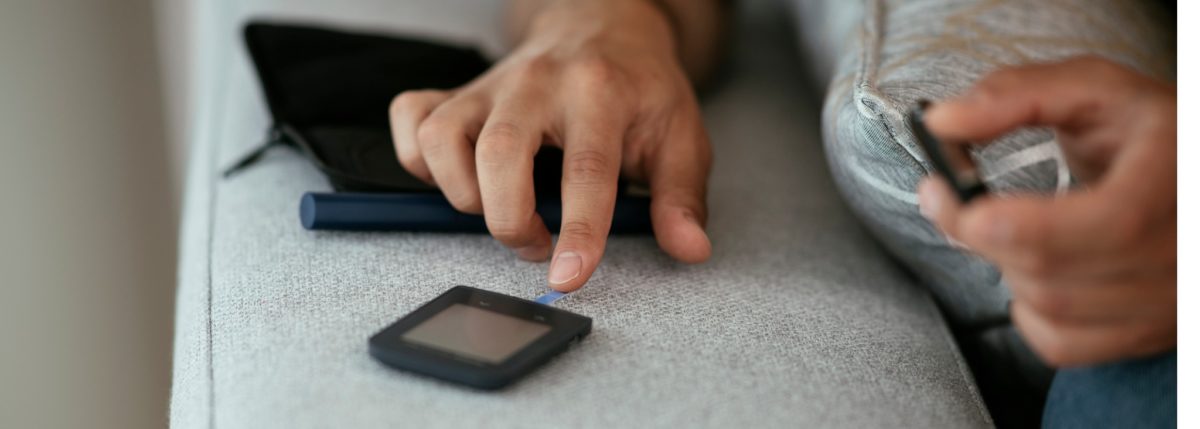Alternate Blood Sugar Site Testing: What to Know
People with type 2 diabetes (T2D) need to keep track of their blood sugar levels to reduce the risks of complications and achieve any other health-related goals. The information you get from self-monitoring with blood glucose meters (BGM) can be invaluable because it helps you and your provider make the best decisions about your diabetes care.
The conventional way to self-monitor is by checking your blood sugar levels on a regular basis using a BGM or a continuous glucose monitor (CGM). When diagnosed with diabetes, a healthcare provider shows how to test blood sugar levels using a lancing device, test strip and a meter.
These checks are typically taken at the fingertips, but did you know it’s possible to check your blood sugar in a place other than your fingers? This is called alternate site testing (AST). In this article, we explore:
- Why people with diabetes would check their blood sugar in places other than their fingertips.
- If glucose readings are more, less, or just as accurate as testing on your fingers.
- When it’s okay to use an alternative site to check blood sugar levels.
Alternate test sites + when to use them
Some people with diabetes would prefer to use an alternative site to check their blood sugar levels because the traditional method can be more painful. Other areas of the body such as your palm, legs, forearm, upper arm and stomach are less sensitive areas compared to the fingertips, which have more nerve endings and therefore can make testing more painful.
One of the obstacles to managing diabetes can be the fear of needles and the pain that comes with testing. It’s normal to want to avoid the pain and discomfort that comes with self-monitoring. Fortunately, today’s lancing devices can adjust the puncture depths to ensure you only prick your fingers as deep as necessary to get a good, accurate test result.
Are AST as accurate as finger pricks?
In short, yes. Alternative site testing can provide similar results as traditional finger pricks. However, this doesn’t mean they are a suitable replacement for the conventional method of checking blood sugar levels.
Why? Because alternative site testing may lag behind traditional finger-pricks by 20 minutes and glucose arrives faster in the fingertips than the other parts of your body. In addition, AST provides similar results when your blood glucose levels are steady and not falling or rising rapidly.
Using AST
If you’re considering checking your blood sugar levels in a place other than your finger, here are some key things to remember on when and when not to use AST. Before deciding on whether to use alternate site testing, speak with your healthcare provider about whether this method will work for you and to help you find an approved meter. Not all blood glucose meters are approved for alternate site testing.
Follow the instructions provided with your testing system for traditional and alternate site testing. Products like Accu-Chek’s FastClix may also mention if their device is approved for such use. Check your BGM’s labeling for approved AST sites. For example, Accu-Chek FastClix is only approved for alternate testing on the ball of the thumb, the ball of the little finger, the underside of the forearm, the upper arm and the top of the forearm.
It’s also important to note that alternative site testing is not recommended for pregnant women.
When to use AST
Even if you’ve decided to test your blood sugar levels using an alternative testing site and have confirmed which site is useable, there are certain times where using AST isn’t recommended. Here are the recommendations for when and when not to use AST:
Do use AST:
- Before a meal
- When fasting or when your blood sugar is stable
- Near bedtime
Don’t use AST:
- When blood sugar levels may be falling quickly (with insulin or exercise)
- When blood sugar levels may be rising quickly (after meals)
- If you are sick or stressed
Key Takeaways
Alternate Site Testing (AST) is testing blood sugar levels in areas other than your fingertips. AST can be just as accurate as traditional testing at the fingertips if blood sugar levels are stable, but may not be if levels are rising or falling quickly. You can talk to your doctor about alternate sites like the forearm, palms, legs, upper arm and stomach. If you would like to try AST, make sure your blood glucose meter is approved for alternate site testing.
Editor’s note: This article is sponsored by Roche Diabetes Care, a founding partner of Beyond Type 2.





